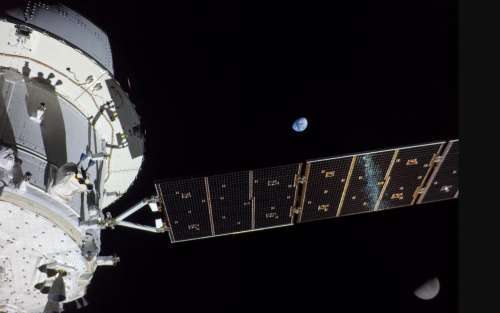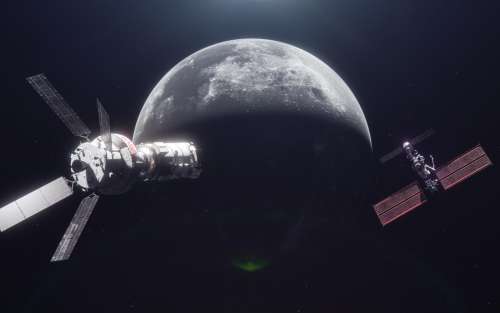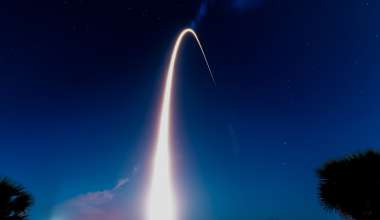Human curiosity and aspiration have fueled the drive to explore the cosmos since well before the dawning of the space age. From the early days of stargazing to our first steps on the Moon, humanity has consistently pushed the boundaries of what is possible in its relentless pursuit of knowledge, discovery, and advancement.
Present-day efforts to return to the Moon aren’t motivated by nostalgia; they represent the beginning of a sustained human presence, economy, and operations in cislunar space, paving the way for future expeditions deeper into and eventually beyond the Solar System. The Artemis Program is harnessing our nation’s expression of this passion for exploration and discovery—setting the stage for continuous lunar habitation and eventual interplanetary travel.
Innovation is essential to overcoming new, complex engineering challenges involved in human spaceflight. The advancements required for a successful and permanent return to the Moon span mission planning, spacecraft design, space domain awareness, human and systems safety, and the development of autonomous systems and sustainable ecosystems in space. In short, innovation in space technology is not simply about making things possible, it is also about redefining human capabilities.
The Aerospace Corporation is at the forefront of the development of cislunar space, collaborating with NASA and other government customers, commercial companies, nongovernmental organizations and international partners to define and refine missions, architectures and system concepts to make the vision of a permanent human presence on and around the Moon a reality.
The Legacy of Success
The first successful U.S. lunar landing, achieved by Apollo 11 in 1969, had profound implications that resonated far beyond the immediate triumph of human ingenuity and technological expertise. It marked a pivotal moment in the Cold War, establishing the United States as a dominant power in the space race against the Soviet Union while showcasing American scientific and engineering prowess to the world.
The landing also spurred a wave of technological innovation, inspiring generations to pursue careers in science, technology, engineering, and mathematics (STEM). Culturally, this landmark achievement unified the nation during a time of social and political upheaval, symbolizing the country’s spirit of exploration and “never say never” sensibility while laying the foundation for subsequent spaceflight efforts.

“Like so many in my generation, I was personally inspired watching the Apollo 11 Moon landing. And like many more today, I remain inspired in our pursuit of a future there,” said Jim Myers, Senior Vice President of Aerospace’s Civil Systems Group. “Cislunar space is the next frontier in space exploration. It is a greenfield in space, and one that could lead to the next great economy. It is also a potential treasure trove of scientific discovery and advancement—a pivotal testbed for nascent space technologies and a proving ground for reaching Mars and other planets.”
Returning to the Moon is a strategic national space priority and holds immense significance for the U.S. space industry. This monumental undertaking underscores the nation’s commitment to the peaceful use and exploration of space and highlights the unending human drive to push the boundaries of what is possible.
Aerospace’s Essential Role
Aerospace remains an indispensable player in returning to the Moon, supporting various mission components of the Artemis Program and, through collaborations with groups—including AIAA, the Lunar Surface Innovation Consortium, and the Space Information Sharing and Analysis Center—playing a vital role in ensuring the cislunar ecosystem is developed with sustainability in mind.
“In our push to return to the Moon, we’re going to back to stay, to finally leave a piece of our civilization on another heavenly body,” said Cristina Guidi, Aerospace’s Assistant General Manager for Human Exploration and Spaceflight. “A permanent human presence in cislunar space requires reliable, resilient and interoperable infrastructure—including situational awareness, power, navigation, and communications capabilities, which do not yet exist in this region of space. We have given significant attention to the extended challenge of delivering these capabilities within a sustainable cislunar ecosystem.”

By providing comprehensive mission lifecycle support, including digital engineering, roadmaps development, and testbeds and proving grounds, Aerospace is helping chart the course and facilitating the realization of these ambitious goals, enabling not just a return to the Moon but also the execution of more frequent and complex cislunar missions.
The moon’s strategic value is of increasing interest to much of the global community, not just the United States, which increases the complexity of leveraging the domain. This endeavor underscores the importance of strategic global partnerships and coordinated technological advancements in realizing our space exploration dreams.
“The Moon is a singular shared experience for every one of us on planet Earth—the one presently accessible destination we can look up and see from anywhere across the globe,” said Myers. “America’s international allies are critical to our success in space. Through the promise of the Artemis Accords, we have a first-of-its-kind opportunity for a multi-national spacefaring partnership, laying the infrastructure and groundwork for a future of human space exploration we will share peacefully with other nations.”





